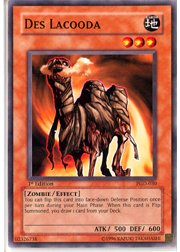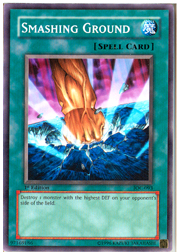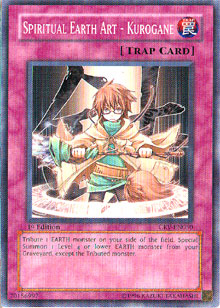Before I get too involved in today’s analysis, I’d like to mention that I made an error in my previous article on Magical Hats. If Dark Coffin or Statue of the Wicked is special summoned as an “empty hat” and attacked by an opponent’s monster, their effects won’t trigger once they’re in the graveyard. This is because Dark Coffin or Statue of the Wicked needs to be flipped face-up in order to calculate damage, and it’s destroyed and sent to the graveyard while it’s face-up. Therefore, its trigger conditions are no longer met. I apologize for overlooking this, and I’d like to thank Tom Schwegler for pointing it out.
While looking through possible options for a new version of Clown Control, I came across many cards that had been overlooked. Some of those cards were suggested by Clown-loving readers who helped contribute to the final version of the new Clown Control deck. However, one card in particular tempted me to experiment with it in various other Control decks. After varying degrees of success, and with an eagerness to explore card-drawing mechanics after seeing Pot of Greed on the list of Forbidden cards in the Advanced format, Des Lacooda quickly became one of my new favorite cards. You’d be surprised at how often you can flip summon this little critter. It’s a valuable asset that makes a variety of Control strategies incredibly consistent, whether they’re conservative or aggressive.
The Basic Breakdown
 Des Lacooda is a monster that shouldn’t be judged by its stats. This little camel possesses several different factors that can make it a desirable card for Control decks. Des Lacooda is a “self-flipper,” which is an ability that was made popular in the Pharaonic Guardian expansion. A self-flipper monster possesses an ignition effect that can be used once per turn. It allows you to flip that monster face-down into defense position, and it’s accompanied by an effect that’s triggered when the self-flipper monster is either flipped face-up or flip summoned. Des Lacooda’s effect is only triggered when it’s flip summoned, which is a necessary balance to its powerful ability.
Des Lacooda is a monster that shouldn’t be judged by its stats. This little camel possesses several different factors that can make it a desirable card for Control decks. Des Lacooda is a “self-flipper,” which is an ability that was made popular in the Pharaonic Guardian expansion. A self-flipper monster possesses an ignition effect that can be used once per turn. It allows you to flip that monster face-down into defense position, and it’s accompanied by an effect that’s triggered when the self-flipper monster is either flipped face-up or flip summoned. Des Lacooda’s effect is only triggered when it’s flip summoned, which is a necessary balance to its powerful ability.
While drawing one card may seem unexciting, it’s actually one of the most powerful tools for decks that are running various stall cards. For example, in last week’s analysis and creation of the new Clown Control deck, I included one copy of Des Lacooda. It gives a potential Clown Control duelist another monster that had the option to be summoned through Giant Rat’s effect. The deck ran two copies each of Messenger of Peace and Level Limit – Area B, along with two copies of Stumbling. The odds that Des Lacooda’s effect could be triggered at least once was relatively high, and it’s a trigger that allows Des Lacooda to pay for itself. If a player could trigger Des Lacooda’s effect more than once during a duel, then he or she would be adding extra cards to his or her hand. This eventually allows that player to see many more cards than the opponent will normally see during a duel, further enhancing the player’s options as well as the chances that he or she can find removal and stall engines even faster.
Of course, Clown Control isn’t the only deck that runs stall cards. Many decks, such as Lava Lockdown—a Burn strategy that utilizes Lava Golem as a win condition and as a form of removal, along with cards like Ojama Trio—can easily incorporate Des Lacooda. This is because the deck naturally runs a variety of stall cards that will keep the opponent from attacking and destroying Des Lacooda. This card-drawing Zombie can help you find Lava Golem a lot faster, or it can help you draw counter-traps (such as Solemn Judgment) that will protect your continuous stall cards.
Des Lacooda isn’t just a valuable tool to the speed and consistency of heavy Control decks; it’s also a Zombie-type monster. Zombies already have powerful stall cards available, such as Spirit Reaper and Patrician of Darkness, and they can also claim Pyramid Turtle, one of the most powerful search effects in the game. Des Lacooda can be summoned by Pyramid Turtle, and it can be special summoned with Book of Life, which further adds to this control monster’s versatility.
Many players have contemplated adding Dekoichi the Battlechanted Locomotive to their decks in order to reduce the risk of topdecking. Dekoichi can be used with Tsukuyomi to provide card advantage, but Des Lacooda can complete the tasks of these two cards by itself. Dekoichi the Battlechanted Locomotive is better suited to an aggressive deck, since it can allow you to draw a card even if it’s flipped up as a result of battle. However, Control decks have no reason to run this level 4 card-drawing monster, since Des Lacooda would be the better option in most general Control strategies.
Both cards serve a similar purpose, but have different weaknesses. It’s important to use the card-drawing monster that best suits your deck. If you’re running Tsukuyomi and your deck doesn’t have access to any stall cards, then Dekoichi the Battlechanted Locomotive would probably be the better option. If you’re running powerful stall elements, such as Level Limit – Area B, then you should use Des Lacooda as your primary source for card advantage.
Combos and Strategies
 If you’re looking for a more aggressive Control strategy that utilizes Des Lacooda, then you should consider a deck that contains a variety of cards that can provide one-for-one trades. Sakuretsu Armor, Widespread Ruin, and Smashing Ground are all powerful forms of removal that provide fair trades with your opponent in terms of card advantage. Des Lacooda and Masked Sorcerer can benefit the most from monster removal, as they’ll provide you with advantage as long as you keep monsters off the opponent’s side of the field. While cards like Sakuretsu Armor will rarely provide you with card advantage over your opponents, Des Lacooda and Masked Sorcerer will be able to pay for the use of your trap cards. This means that the cards you use up in order to destroy monsters will be replenished through your card-drawing effects. In contrast, your opponent won’t recover his or her card presence quite as quickly. This leaves you with more options, and your available forms of removal and card drawing may be too much for an opponent to deal with if he or she is stuck topdecking.
If you’re looking for a more aggressive Control strategy that utilizes Des Lacooda, then you should consider a deck that contains a variety of cards that can provide one-for-one trades. Sakuretsu Armor, Widespread Ruin, and Smashing Ground are all powerful forms of removal that provide fair trades with your opponent in terms of card advantage. Des Lacooda and Masked Sorcerer can benefit the most from monster removal, as they’ll provide you with advantage as long as you keep monsters off the opponent’s side of the field. While cards like Sakuretsu Armor will rarely provide you with card advantage over your opponents, Des Lacooda and Masked Sorcerer will be able to pay for the use of your trap cards. This means that the cards you use up in order to destroy monsters will be replenished through your card-drawing effects. In contrast, your opponent won’t recover his or her card presence quite as quickly. This leaves you with more options, and your available forms of removal and card drawing may be too much for an opponent to deal with if he or she is stuck topdecking.
Des Lacooda can be extremely powerful when it’s combined with recursion cards that are spell speed two. By activating Call of the Haunted during your opponent’s end phase, you can special summon Des Lacooda from your graveyard outside of the battle phase, when a monster could run over your card-drawing camel, and safely past the main phase, when your opponent has the most options available to destroy monsters. This gives you the opportunity to flip down Des Lacooda during your upcoming main phase, and it will also allow you to flip summon it during that same turn. This will automatically put you one card ahead of your opponent, even if he or she manages to remove Des Lacooda from the field during the next turn outside of battle. Be aware that if your opponent destroys Des Lacooda as a result of battle, then you’re still drawing one card and losing one card.
 Earth Control decks will grow to love Des Lacooda, and those players will probably learn to love Spiritual Earth Art – Kurogane as well. After Des Lacooda has helped you draw a few cards, you can tribute it to Spiritual Earth Art – Kurogane in order to summon a different Earth attribute Control element from your graveyard, such as Dream Clown or Exiled Force. The best part about this is that Des Lacooda gives you enough cards to cover the cost of tributing a monster with the Earth attribute, so you’ll lose no major advantage by using Spiritual Earth Art – Kurogane. In fact, if you activate this trap card in response to a card that would destroy your Des Lacooda or Spiritual Earth Art – Kurogane, then you’ll end up with more advantage than your opponent. If you have another Des Lacooda in your graveyard, then Spiritual Earth Art – Kurogane can be an effective counter to some of your opponent’s standard removal cards.
Earth Control decks will grow to love Des Lacooda, and those players will probably learn to love Spiritual Earth Art – Kurogane as well. After Des Lacooda has helped you draw a few cards, you can tribute it to Spiritual Earth Art – Kurogane in order to summon a different Earth attribute Control element from your graveyard, such as Dream Clown or Exiled Force. The best part about this is that Des Lacooda gives you enough cards to cover the cost of tributing a monster with the Earth attribute, so you’ll lose no major advantage by using Spiritual Earth Art – Kurogane. In fact, if you activate this trap card in response to a card that would destroy your Des Lacooda or Spiritual Earth Art – Kurogane, then you’ll end up with more advantage than your opponent. If you have another Des Lacooda in your graveyard, then Spiritual Earth Art – Kurogane can be an effective counter to some of your opponent’s standard removal cards.
Final Thoughts
Des Lacooda is powerful. It’s ridiculously powerful. If you manage to get two copies of this monster onto the field and you’re running forms of negation (such as Solemn Judgment) to protect your key monsters and continuous cards, then you’re probably going to win the duel. A Control deck needs cards that make its strategy more consistent and its card presence more dominating than the opponent’s options. Des Lacooda is that card-drawing source that Control duelists will need in this new Advanced format. The combos available to Des Lacooda may not be as crazy as the combos that are available to Magical Hats, but Des Lacooda doesn’t need combos to prove its usefulness. It’s a solid resource engine, and that’s what makes this little critter such a powerhouse.
If you have any questions, comments, or concerns with this week’s article or previous articles, feel free to email me at Mrosenberg at Metagame dot Com.